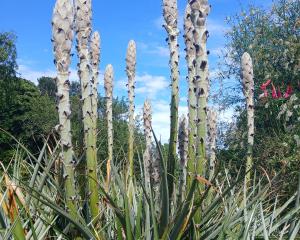Laid out in 1935, during Alfred Buxton's second foray into South Otago, Lesmahagow, in Benhar, retains original elements, including some fine trees, part of the orchard and the remains of a grotto.
Kate and Noel O'Malley, who have owned the property for 36 years, do not have the plans drawn up for pottery-owner Peter McSkimming - who named the property after the Scottish town where his ancestors came from - but they do have copies of photographs taken during the garden's creation by Frank Neate, one of Buxton's employees.
The house had been built some 20 years earlier on a north-facing hill. There was a large heated glasshouse and a propagation shed, but the O'Malleys removed the glasshouse, whose woodwork had become dangerously rotten.
Its heating pipes remain, though, as do the water containers located in the greenhouse so plants would never have the shock of icy water.
The back wall of the greenhouse was brick, and Buxton made extensive use of McSkimming bricks at Lesmahagow, adding brick steps, including a set from the terrace in front of the house to the croquet lawn. There were similar steps on either side of the sunken rose garden and brick walls surrounded the main part of the garden.
There was also a pergola running along two sides of the rose garden.
The steps and pergola still define the garden and Kate says: "We've always been able to see the outline, the structure of the garden, and we've stuck with that."
She has not followed the example of Mrs McSkimming and grown orchids, but she and Noel grow tomatoes, capsicums and chillies in a tunnel house, and Noel has a well-stocked vegetable garden. He is keen, too, on propagating native plants, particularly kowhai.
When the O'Malleys bought Lesmahagow, the property was very overgrown.
"We borrowed a goat for six weeks," Kate says, recalling initial efforts to tame the garden.
They removed a large cabbage tree and flaxes near the house, and "gorgeous crab apples that were dying in the middle".
When one of four large columnar conifers died, symmetry was lost, so when a second died, the decision was made to take out the remaining pair. They also lost large old rhododendrons that died after too-drastic pruning.
Despite those losses, much remains from the 1930s. Almost certainly original are a huge variegated holly (a Buxton favourite), prunuses, oaks, numerous conifers, kowhai and hoherias, as well as apples and pears in the orchard.
The O'Malleys have replanted in the spirit of Buxton. Having seen a photograph that showed roses growing close to the house, they planted roses there but, rather than replant the four beds in the sunken rose garden, now grassed over, Kate grew standard white Iceberg roses around the perimeter.
This neutral look is deliberate, as the sunken rose garden, which is very sheltered, is popular as a wedding venue.
The pergola looks as good as it did 75 years ago, thanks to new timber, carefully cut to replicate the original boards, and recladding of the brickwork pillars. The single-brick wall to the east of the pergola has been strengthened, with huge braces inserted behind it.
"We came so close to losing it," Kate says of the wall, which an engineer advised them to demolish.
To the north of the decorative garden was a tennis court, on one side of which the O'Malleys found the ruins of a grotto, a trademark Buxton folly. They are hopeful that more photographs of Lesmahagow will come to light, so that they can discover not only what the grotto originally looked like but how other parts of the garden have evolved.
• TELL US MORE
Do you know of other Buxton gardens in the south; have plans, layout drawings or other material about his gardens, or early photographs of Lesmahagow or other Buxton gardens? If so, please contact Gillian Vine, ODT Features, PO Box 181, Dunedin 9054; email gillian.vine@odt.co.nz or phone her on (021) 705-708.












